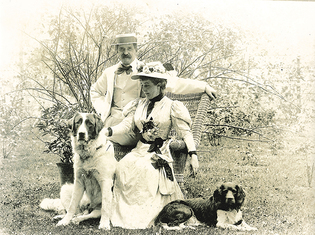
Manuscripts and archives
Ellen Battell Stoeckel—shown here with her husband, Carl, and their dogs—gave the university her estate. It is now a bucolic retreat for the Yale Norfolk Summer Schools of Music and Art.
View full image
Although Yale was all-male until 1869, women have been generous donors to Yale for three centuries. Their innovative gifts include the first scholarship for African Americans, a music school, facilities for the modern study of geology, a tuberculosis hospital, and a model residential college featuring an iconic landmark tower. Here, we recognize just a few of the many women whose gifts have enabled Yale to fulfill and expand its educational mission.
The earliest published record of a donation by a woman is from 1717: a contribution of ten pounds “for College expenses by Madame Saltonstall,” the wife of Gurdon Saltonstall, who was governor when the Collegiate School (the name it had before it became Yale) was moved from Saybrook to New Haven. “A patron of colleges and churches, she gave a hundred pounds to Harvard college, and the same sum to Yale,” before the death of the Governor in 1724, “and by will, a thousand pounds to Harvard, to assist two young men of bright parts and sober lives intended for the ministry,” according to an 1836 biography.
In 1871, Mary Ann Goodman, a Black New Haven woman, made a remarkable bequest to Yale. Excepting a $100 annuity for her father, she gave her entire estate to Yale for scholarships in the theological department, to be used in “aiding young men in preparing for the Gospel ministry, preference being always given to young men of color.” Goodman died unexpectedly after a short illness, on January 26, 1872, at the age of sixty-eight. Reporting on her death, the New Haven Daily Palladium called her bequest “all the more remarkable” because “she earned her living washing and cleaning.” The paper also reported that “as she had provided no place of burial for herself, she was fitly interred in the lot in the old cemetery [Grove Street] belonging to the university of which she has become a benefactor.” The Yale Corporation provided the inscription: “Mary A. Goodman, of African descent, who gave the earnings of her life to educate men of her own color in Yale College for the Gospel ministry.”
The Battells of Norfolk, Connecticut, were known for their musical talents. Robbins Battell, Class of 1839, was an accomplished composer and performer. His sister Irene, organist, choral conductor, and acclaimed singer, moved to New Haven in 1843 as the bride of professor William A. Larned ’26 and enriched its music culture. In 1862, she established a Yale library of scholarly music editions. In the 1870s, she persuaded her brother Joseph to fund both an instructorship in sacred music for Gustave Stoeckel—the first European-trained music teacher in the city—and the construction of Battell Chapel, to serve as Yale’s concert hall and to showcase her gift of its organ. Irene and her sister Urania endowed a music fund. A third sister, Ellen, gave $20,000 so the fund could endow a chair in music. Robbins Battell’s daughter, also named Ellen, married Stoeckel’s son Carl. After years of hosting music festivals on their estate in Norfolk, Ellen Battell Stoeckel bequeathed the property to Yale; it is now the home of the Yale Norfolk Summer Schools of Music and Art.
Lucy Hall Boardman (1819–1906) lived on Hillhouse Avenue for years as the widow of US congressman William Whiting Boardman ’12. She devoted her time to philanthropy, endowing mainly white and Black churches, the YWCA, the Home for the Friendless (now the Mary Wade Home), and Yale. She is especially remembered locally as the donor of the innovative coeducational Boardman Trade School. In 1902, Mrs. Boardman gave Yale the money for a new building at 2 Hillhouse as a memorial to her uncle, Jared Potter Kirtland 1815MD, the first matriculated student in the Yale School of Medicine. Kirtland Hall, a neo-Renaissance building of East Haven brownstone, housed the geology department until 1963. It is now home to the psychology department.
Among Yale’s most fascinating benefactors is Sarah L. Pardee Winchester (1839–1922), the wife of William Wirt Winchester, principal owner of the Winchester Repeating Arms Company in New Haven. After his death from tuberculosis in 1881, she settled in California and over many years designed and constructed the sprawling mansion in San Jose that became a major tourist attraction, the Winchester Mystery House. With funds entrusted to Yale dating from 1909, Sarah Winchester built as a memorial to her husband the William Wirt Winchester Hospital for tuberculous patients in West Haven. Leased by the military after World Wars I and II, it eventually became a Veterans Administration hospital; its previous mission is now carried out in the Winchester Chest Clinic at Yale New Haven Hospital.
Anna Richardson Harkness (1837–1926) was the donor of the Harkness Memorial Quadrangle—now Branford and Saybrook Colleges—in memory of her son Charles Harkness ’83, who died in 1916. A major shareholder in the Standard Oil Company, she established the Commonwealth Fund with her son Edward S. Harkness ’97, who later funded the Yale residential college system. In 1920, she gave an additional $3 million gift to Yale to raise faculty salaries. Her daughter-in-law Mary Stillman Harkness (1874–1950) donated the Gutenberg Bible to the Yale Library in her memory.
 loading
loading